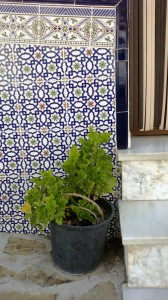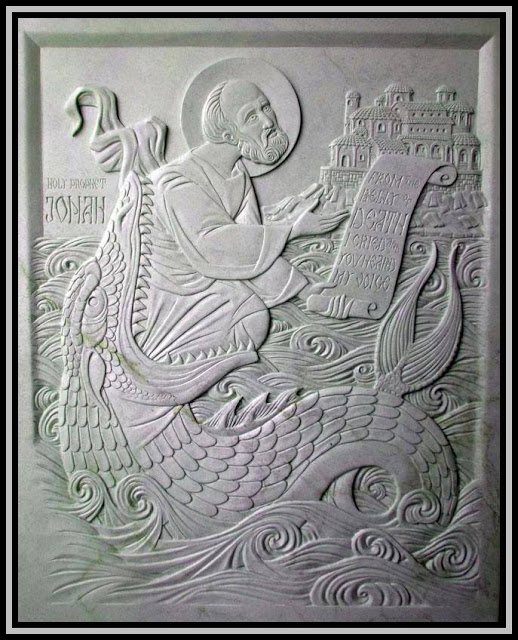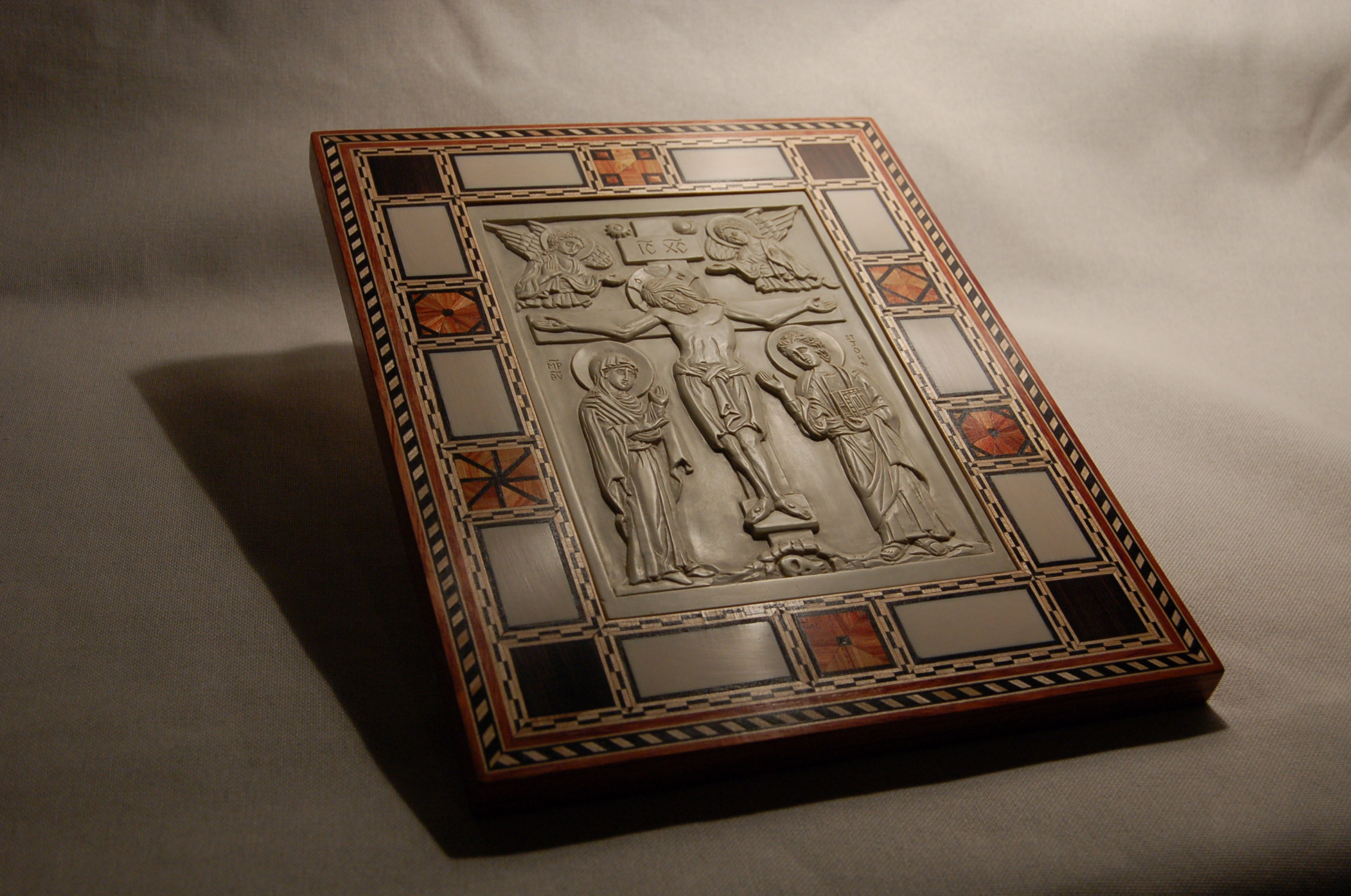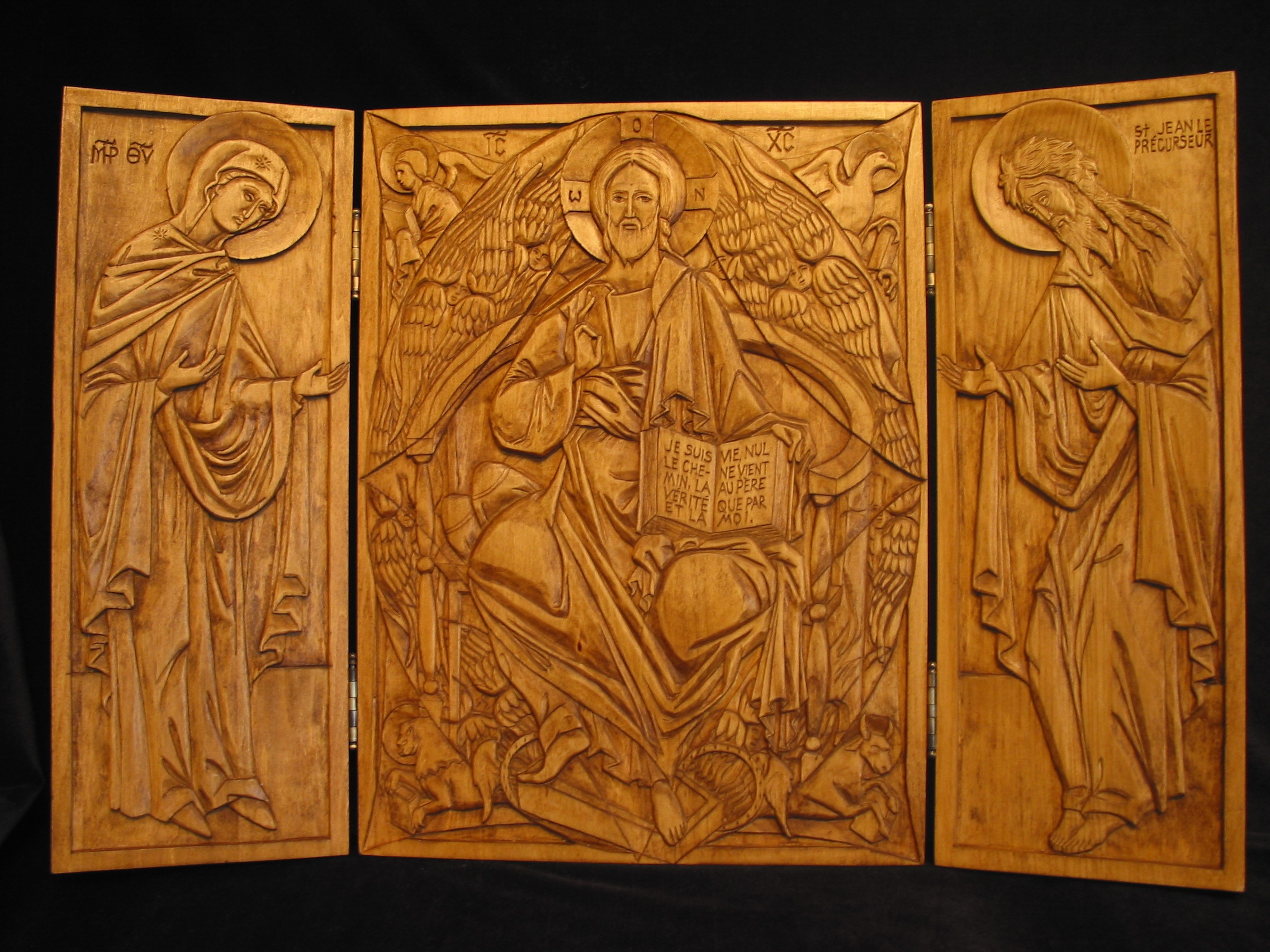Register for a unique event about one of the most intriguing women in history with one of today’s most prolific sacred artists and widely-viewed cultural commentator Jonathan Pageau!
Join an online interactive discussion with iconographer Jonathan Pageau, Jan 30th.
Scala Foundation Conference In Princeton, NJ, April 2023 Featuring Aidan Hart, Jonathan Pageau, Peter Carter and David Clayton
Aidan Hart on Beauty, Matter and the Sacred
The Spirituality of Artistic Creativity - Find Your Personal Pilgrimage
Christianity's Neglected Cultural Weapons - Signs and Symbols
Florentine Street Shrines - Can We Do This Today? Will Today's Della Robbia Please Step Forward?
When I was studying portrait painting in Florence, several years ago, I was struck by the charm of the old street shrines that can be seen built into the walls of the buildings that line the narrow streets. Many date back to the time of the building itself.
Not all are still obviously the focus for prayer, many seemed to unnoticed in a city in which Renaissance art abounds and much of the population has fallen away from the Faith.
Since then I have wondered, from time to time, if this is something we could do today, in a time and in places where Catholicism is not the dominant faith and the driving force the culture?
My feeling is we might, in many instances, struggle to persuade local government to go along with such a thing. However, perhaps if done tastefully and discretely on private property that is visible from the public street it might be possible.
I suggest that if what is done is truly beautiful, even non-believers would want it and it would, to a large degree, disarm potential critics by removing their desire to be offended by outward signs of the Faith. I have a friend who runs a menswear shop in the UK and he always places a small icon of the face of Christ, a Mandylion, which is just 6' x 4' in size, low down on the wall behind the counter. While it is not an obviously bold statement of faith, he deliberately places in such a position that when people pay for their clothes, they will see it on the wall behind the till in such a way that it gives the impression that they are peeking into his personal space and seeing an image that is their for his private devotion. He says that nobody ever objected, and many asked about it.
Non-Christians (and for that matter many Christians too) are much more likely to be irritated if the art is ugly or sentimental. I have often wondered, for example, if the militant secularists are in fact doing us a favor by objecting to the kitsch shopping mall nativity scenes that seem to be standard issue for retailers nowadays. Perhaps they are the unwitting agents of the Holy Spirit? Before my conversion in my early thirties, piped carol music and brightly-colored plastic McChristmasses gave me the impression that Christianity was for saddoes who didn't even know that they ought to be embarrassed by being associated with this stuff. This did far more to put me off the Church than tales of Popes fathering illegitimate children or the brutality of the Teutonic Knights in the Baltic and the Middle East!
If we did decide to do this, what form should it take?
Well, here's an idea. I recently posted a photo of my first stab at creating an outdoor icon corner in a balcony garden.
I am hoping that as the plants grow through spring and summer that the hard edges will soften and overgrow, slightly the images. The paintings are prints that I obtained from a website selling them on rustic wooden planks, which I have varnished and screwed to the stool, which came from a consignment store.
A reader saw the photos and got in touch with me, suggesting that someone might like to start producing ceramic tiles with the standard core images of the icon corner - Our Lady on the left, the crucifixion in the center and the Risen Christ on the right which could then be set into the wall.
I do not know the economics of tile production but wouldn't it be wonderful if we could have beautiful triple sets of tiles? I imagine they might be something like the Della Robbia ceramics, except stylistically gothic or iconographic (just to suit my personal taste) and polychrome. Maybe in the form of a Jonathan Pageau relief carving!
Here is an original Della Robbia:
I once wrote a feature on my blog, thewayofbeauty.org, on how houses in southern Spain have tiles containing geometric patterns set into the walls of their houses - a Christianization of the Islamic cultural inheritance, here: Geometric Tile Patterns in Andalusia.
Perhaps we could have a combination of the two ideas in which we start to have simple icon-corner triple sets set into such patterns? If done well, it could the house prices up - even if you are selling to an atheist, I suggest!
Just a thought.
Where Can Catholics Learn to Paint or Carve Icons? Go to Hexaemeron.org
I am often asked for recommendations of classes that would be good for Catholics to learn traditional iconography. One place to consider is Hexaemeron.org which has just announced the first of its icon painting and icon carving courses for 2018. They are now taking students for their 'Six Days of Creation' integrated series of workshops for different levels of experience. Go to their site for more details.
Furthermore, you can earn credit on these classes from Pontifex University that would be recognized as part of studio requirement of their Master of Sacred Arts degree. Again, details can be found at Hexaemeron.org and www.Pontifex.University.
Hexaemeron.org a non-profit based in the US which was founded in 2003 which offers short courses and workshops in a variety of locations around the world but has its main focus in North America. It is founded by Orthodox Christians and is welcoming and respectful to Roman and Byzantine Catholics.
All their classes in painting, carving and embroidery are always of the highest quality and the work of two of their teachers has been featured in the past on this site. Some readers will be familiar with painter Marek Czarnecki, who is Catholic. I wrote about two icons of Western saints that he painted for Our Lady of the Mountains, in Jasper Georgia, here.
Here is his Saint Cecilia:
Another teacher that readers may be familiar with is the Canadian icon carver, Jonathan Pageau. Here is his icon of Jonah.
A Carved Gospel Book Cover by Jonathan Pageau and Andrew Gould
Here is a gospel book cover. The relief carving in the central portion is by Jonathan Pageau a Canadian based in Quebec and the striking veneer frame is made by Andrew Gould who is based in South Carolina. Both are part of a group of liturgical artistans who call themselves New World Byzantine Studios. For the icon painters amongst you, they make gessoed icon boards with raised borders as well
Andrew told me that the inspiration for the marquetry work came from both Christian and Islamic sources. I am interested especially in his reference to the crossover between the Christian and the Islamic in geometric pattern. We have seen it before in articles about Romanesque Sicily for example. Here, Andrew describes how he based his designs on Greek designs from the 17th century (when occupied by Turks) and also modern Islamic designs from north Africa. He wrote as follows:
"My design for the gospel cover has two sources. In the 12th-13th centuries, it was common for the western church to set an old Byzantine ivory icon in a gold frame as a gospel cover. Orthodox gospel covers are usually a little different. They either consist of one large icon covering the whole cover, or five small icons (evangelist around the crucifixion). The former is impractical for stone, and the latter too expensive. So I decided to go with the western style in order to accommodate one of Jonathan's carvings. The back cover bears a second icon, with the resurrection. In Orthodox practice, the gospel is placed on the altar with the back cover facing up during Paschatide, so this icon must be on the back.
The marquetry frame around the icons is a style that was very typical in Greek Orthodox art in the 17th century. There is still plenty of furniture on Mt Athos and other old Greek Monasteries that is covered with this sort of inlay. It is really an Islamic style of woodwork, still current on Moroccan and Egyptian imports. I find it highly flattering to relief icons, and it reads very well in the dim light of Orthodox churches, so I advocate reviving this sort of ornamentation for Orthdox liturgical use.
I used marquetry inlay banding (which is available for musical instrument makers) and salvaged ivory from pipe organ keys. There is no specific explanation for the pattern itself, except that I wanted it to convey the power and significance of the events depicted."
The Relief Carving of Jonathan Pageau
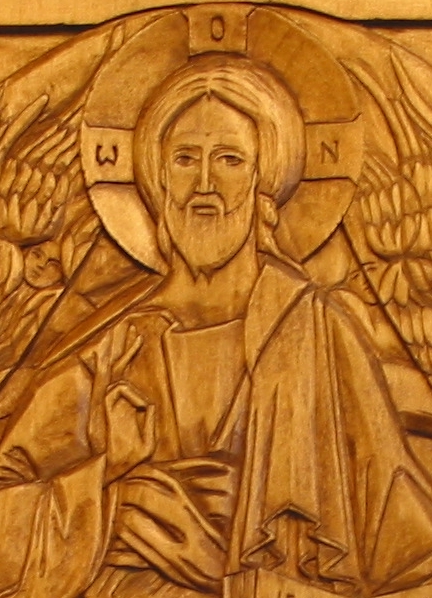 Here is some relief carving by Jonathan Pageau, an artisan based in Canada. Jonathan is Orthodox and is working very much within the iconographic form, the principles of which he will not compromise, as one would expect. However when I chatted with him about his work, it struck me that as well the more familiar Eastern forms, he has an interest in traditional Western forms of iconographic art as well.He is happy therefore to consider the portrayal of some Western types that are not part of the usual Eastern canon. He works in wood and a soft soapstone from Kenya called Kisii stone.
Here is some relief carving by Jonathan Pageau, an artisan based in Canada. Jonathan is Orthodox and is working very much within the iconographic form, the principles of which he will not compromise, as one would expect. However when I chatted with him about his work, it struck me that as well the more familiar Eastern forms, he has an interest in traditional Western forms of iconographic art as well.He is happy therefore to consider the portrayal of some Western types that are not part of the usual Eastern canon. He works in wood and a soft soapstone from Kenya called Kisii stone.
I am fascinated by relief carving, and wrote an article previously about some the principles behind it here. I have limited experience of sculpting in clay, in which I created a full three dimensional form in a traditional naturalistic style. This was an additional class when I was studying primarily academic drawing and painting in Florence several years ago. At the level I was working at, I found it in many ways easier to pick up than painting. When painting, the artist has to process the information received via the eye from a 3-dimensional form in such a way that he produces a 2-dimensional image is absent in naturalistic sculpture. This conversion from 3-D to 2-D is not necessary in sculpture and the final image is 3-D also. So in this respect it is a simpler process.
I have not attempted relief sculpture but it always struck me as more complicated than naturalistic sculpture requiring a controlled conversion of 3-dimensional information - into a part 3-, part 2-dimensional image.
 When I asked Jonathan about it, he described a process in which the 3-diminsional ideal is converted into a fully 2-dimensional image first – a drawing – and then this is converted back into the partially 3-dimensional form of the relief carving. So his first step is to draw the full line drawing, which must be just as detailed as if he were ultimately painting an icon rather than carving it. Next, this drawing is transferred onto the surface of the stone. He uses tracing paper to do this. Then he cuts around the main shapes to produce a vertical, stepped edge. After this the subtleties of shadow are introduced by introducing varying slopes on those edges and detail within the shapes. I asked him to send me some photos of work in progress to help give us an idea of the method. This he kindly did and these are shown below and right.
When I asked Jonathan about it, he described a process in which the 3-diminsional ideal is converted into a fully 2-dimensional image first – a drawing – and then this is converted back into the partially 3-dimensional form of the relief carving. So his first step is to draw the full line drawing, which must be just as detailed as if he were ultimately painting an icon rather than carving it. Next, this drawing is transferred onto the surface of the stone. He uses tracing paper to do this. Then he cuts around the main shapes to produce a vertical, stepped edge. After this the subtleties of shadow are introduced by introducing varying slopes on those edges and detail within the shapes. I asked him to send me some photos of work in progress to help give us an idea of the method. This he kindly did and these are shown below and right.
This means a relief sculptor using this method must be a good draughtsman. In contrast it is conceivable that someone could sculpt well in the naturalistic style, but is unable to draw well (and I have met one or two good sculptors who claimed that they couldn’t draw).
I have shown below completed works of a Russian Deisis, with Christ in glory (detail above), Our Lady and John the Forerunner ('Jean le Precuseur'); and of St George.
His website with more photographs and information is at http://pageaucarvings.com/ .
Work in progress



















